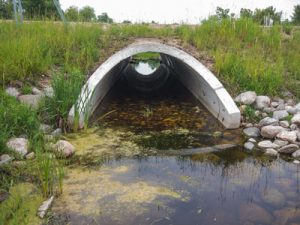
This online workshop will help culvert designers efficiently and consistently develop public waters culvert projects with respect to aquatic organism passage (AOP) and stream connectivity. Attendees will learn how to apply best practices and appropriate calculations, starting from the basis of field-identified stream metrics. The training will use and expand on content from the 2019 Minnesota Guide for Stream Connectivity and Aquatic Organism Passage Through Culverts (PDF).
The free workshop will begin with a self-paced learning component, available to participants for two weeks, followed by an instructor-led interactive online session. The self-paced learning will feature a series of short video presentations totaling approximately four hours, including virtual field data collection. The instructor-led session will provide an opportunity for discussion, questions, and review of work completed in the self-paced training.
Six sessions of the workshop will be offered; each session includes identical content. Limited spots are available in each session, so register early to secure your preferred dates!
Session Dates
Self-Paced
- November 5-7, 2020
- January 7-19, 2021
- February 11-23, 2021
- March 18-30, 2021
- Mary 6-18, 2021
- June 3-15, 2021
Live Session
- November 18, 2020, 1:00 – 3:30pm
- January 20, 2021, 1:00 – 3:30pm
- February 24, 2020, 1:00 – 3:30pm
- March 31, 2021, 1:00 – 3:30pm
- May 19, 2021, 1:00 – 3:30pm
- June 16, 2021, 1:00 – 3:30pm
Registration
- MnDOT employees: Please obtain supervisor approval, then contact Amanda Klawiter via email or 651-366-5284 to register.
- Other participants: Register online
- Cost: Free!
Who Should Attend
Culvert designers, hydraulic engineers, hydraulic inspectors, watershed district staff, regulatory staff, and anyone interested in developing public waters culvert projects with respect to aquatic organism passage (AOP) and stream connectivity.
Learning Objectives
- Understand ecological basis for AOP/stream connectivity culvert design
- Recognize regulatory situations where fish passage through culverts is required
- Learn best practices for stream connectivity and AOP and why these practices are beneficial
- Understand stream, landscape, and other factors that may favor a certain type of culvert design
- over others for a given situation
- Learn basic stream crossing field data collection parameters and techniques
- Understand how to use field data to improve culvert design
- Recognize benefits of culvert designs for stream connectivity and AOP and costs/problems that
- are associated with underperforming culvert designs
- Apply lessons learned from training to road crossing projects
Course Instructors
- Jessica Kozarek, Research Associate and Outdoor StreamLab Manager, St. Anthony Falls Laboratory, College of Science and Engineering, University of Minnesota
- Christian Lenhart, Research Assistant Professor, Department of Bioproducts and Biosystems Engineering, University of Minnesota
- Matt Hernick, Associate Engineer, St. Anthony Falls Laboratory, College of Science and Engineering, University of Minnesota
Technical Requirements
The self-paced material will utilize the Canvas platform, requiring speakers or headphones and an Internet connection and browser, but no special software. The live session will be held using Zoom; it requires a microphone and video camera for full interaction with course peers and instructors.
More Information
For more information on workshop content, contact Matt Hernick or visit the workshop web page. For registration questions, contact Katherine Stanley.
Sponsors
This workshop is sponsored by the Minnesota Department of Transportation and facilitated by Minnesota LTAP at the University of Minnesota.